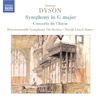Dyson Orchestral Works
A generous programme of unjustly neglected but colourful works
View record and artist detailsRecord and Artist Details
Composer or Director: George Dyson
Genre:
Orchestral
Label: Naxos
Magazine Review Date: 7/2005
Media Format: CD or Download
Media Runtime: 73
Mastering:
Stereo
DDD
Catalogue Number: 8 557720

Tracks:
| Composition | Artist Credit |
|---|---|
| At the Tabard Inn |
George Dyson, Composer
Bournemouth Symphony Orchestra David Lloyd-Jones, Conductor George Dyson, Composer |
| Symphony |
George Dyson, Composer
Bournemouth Symphony Orchestra David Lloyd-Jones, Conductor George Dyson, Composer |
| Concerto da chiesa |
George Dyson, Composer
Bournemouth Symphony Orchestra David Lloyd-Jones, Conductor Duncan Riddell, Violin George Dyson, Composer Helen Cox, Violin Stuart Green, Viola Timothy Walden, Cello |
Author: Edward Greenfield
First heard in 1937, Dyson’s Symphony in G is the most ambitious of his orchestral works, so a fine new recording like this is welcome, particularly at super-budget price. Acclaimed at its first performance, the Symphony subsequently fell into neglect as it followed on from a striking sequence of symphonies written by British composers in the 1930s such as Vaughan Williams, Walton, Bax and Moeran. In the first two movements, Dyson’s determination to strike a contemporary pose in an era symphonically dedicated to Sibelius seems to inhibit his natural melodic gift, with often fragmentary thematic material rarely developing into a tune.
Yet in the third movement variations – taking the place of a Scherzo – and most of all in the colourful finale, any inhibitions evaporate in warm, free and colourful writing, echoing that in Dyson’s Chaucerian choral work The Canterbury Pilgrims. Helped by clear, well-balanced recording, David Lloyd-Jones conducts a brilliant performance that clarifies textures noticeably more than in Richard Hickox’s version, in which a warmly expressive reading is matched by rather reverberant recording.
Each of the three movements of the Concerto da chiesa for strings of 1949 is based on a medieval hymn melody, with Veni Emmanuel inspiring a darkly dedicated slow first movement. It is among Dyson’s finest inspirations, a lament no doubt reflecting his mood after the Second World War. That melody returns transformed at the end of the joyful finale, which is based on the vigorous psalm tune Laetatus sum. The central Allegretto uses the carol-like Corde natus for lightly scored and fanciful variations. As in Elgar’s Introduction and Allegro and Vaughan Williams’s Tallis Fantasia, solo strings are beautifully and atmospherically set against the full string band, enhanced here by fine separation in the Naxos recording. In every way this is a work that deserves to be included among the formidable array of great string works by British composers, a neglected masterpiece.
Originally designed to introduce The Canterbury Pilgrims, the overture At the Tabard Inn makes an attractive addition to a well-filled disc. All three works are superbly played by the Bournemouth Symphony Orchestra under David Lloyd-Jones, and vividly recorded.
Yet in the third movement variations – taking the place of a Scherzo – and most of all in the colourful finale, any inhibitions evaporate in warm, free and colourful writing, echoing that in Dyson’s Chaucerian choral work The Canterbury Pilgrims. Helped by clear, well-balanced recording, David Lloyd-Jones conducts a brilliant performance that clarifies textures noticeably more than in Richard Hickox’s version, in which a warmly expressive reading is matched by rather reverberant recording.
Each of the three movements of the Concerto da chiesa for strings of 1949 is based on a medieval hymn melody, with Veni Emmanuel inspiring a darkly dedicated slow first movement. It is among Dyson’s finest inspirations, a lament no doubt reflecting his mood after the Second World War. That melody returns transformed at the end of the joyful finale, which is based on the vigorous psalm tune Laetatus sum. The central Allegretto uses the carol-like Corde natus for lightly scored and fanciful variations. As in Elgar’s Introduction and Allegro and Vaughan Williams’s Tallis Fantasia, solo strings are beautifully and atmospherically set against the full string band, enhanced here by fine separation in the Naxos recording. In every way this is a work that deserves to be included among the formidable array of great string works by British composers, a neglected masterpiece.
Originally designed to introduce The Canterbury Pilgrims, the overture At the Tabard Inn makes an attractive addition to a well-filled disc. All three works are superbly played by the Bournemouth Symphony Orchestra under David Lloyd-Jones, and vividly recorded.
Explore the world’s largest classical music catalogue on Apple Music Classical.
Included with an Apple Music subscription. Download now.

Gramophone Digital Club
- Digital Edition
- Digital Archive
- Reviews Database
- Events & Offers
From £9.20 / month
Subscribe
Gramophone Club
- Print Edition
- Digital Edition
- Digital Archive
- Reviews Database
- Events & Offers
From £11.45 / month
Subscribe
If you are a library, university or other organisation that would be interested in an institutional subscription to Gramophone please click here for further information.






